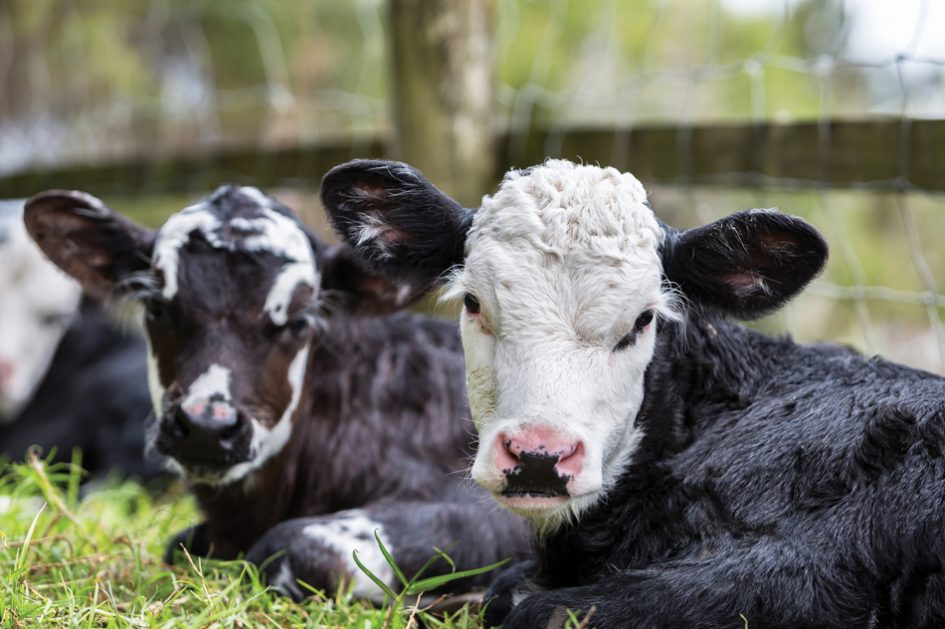Dollars and Sense
Calf implants add profit at all levels of the cattle industry.
By Nicole Lane Erceg
The promises of implants may almost seem too good to be true — additional gains, more feed-efficient cattle, faster growth and heavier weaning weights are all promises of using the technology. Though it may appear far-fetched to those unfamiliar with implanting, Mark Corrigan, Ph.D., ruminant nutritionist and technical services manager for Merck Animal Health, says for cattle producers looking to turn a profit, an implanting program is just common sense.
“Assuming we utilize the proper implant for the proper stage of production that an animal is in, there is always a return on investment from an economic standpoint whenever you use implants,” says Corrigan.

Implants, a small pellet inserted into the ear of cattle that slowly releases hormones to regulate growth and feed efficiency, have been approved for use in cattle since 1954. However, stigmas around the safety of implants, the marketability of implanted cattle and the investment of cattle handling have all been barriers to cow-calf producers embracing the technology.
Added value
Implants allow producers to increase the efficiency with which feedstuffs are used by the animal and are considered to provide the most economic return of any type of technology-added management practice on the farm. Implants on average have the potential to add as much as 5 percent more pounds to the calf crop and they impact each level of the cattle production chain in different, but beneficial ways.
“In the case of the cow-calf operation we are able to add an additional 23 pounds of body weight with a minimal increase in the calf intake of feedstuffs,” says Corrigan, citing data collected in studies of Merck’s Ralgro calf implant.
For the stocker operator, Corrigan says they can expect an increase in average daily gain of up to 15 percent and another 15 to 20 percent in average daily gain in the finishing phase, adding 50 to 90 pounds of additional carcass weight to implanted cattle. For the cow-calf producer, Corrigan says that utilizing an implant could mean a significant per head profit, even with lower prices.
For example, if the assumed market price per pound is $1.30, a 600-pound calf would bring $780 and its heavier, implanted counterpart would bring about $810, which is a $30-per-head price difference. Once the added cost of the input, valued at $3 per head is added in, there is still a more than $25 price difference. Another way to look at the economic value is a non-implanted calf would need to earn a premium of $27-plus for going into a natural, organic or another type of non-implanted program.
For producers not already using implants, Corrigan says, “It’s really just leaving money on the table.”
Addressing concerns
About 30 percent of cow-calf producers implant calves; however, Corrigan says that 95 percent or more of cattle that are slaughtered in the U.S. receive an implant at some point in their life. Corrigan says producers reluctant to implant should not be deterred from using the technology based on concerns for cattle marketability or safety. He says that the common perception that cattle will be discounted in a sale barn for having an implant is completely false.
Merck Animal Health, in partnership with Superior Livestock Auctions, has audited several cattle buyers, sellers and auctions. They have not been able to show that there is any financial benefit to not implanting calves.
“As we surveyed the same types of cattle, the implanted and non-implanted cattle always brought the same amount of money,” says Corrigan.
Finding time to implant has also been a reason voiced by cow-calf producers for avoiding the profitable practice, but Corrigan says that implant programs can be designed around times when cattle will already be handled. Implanting during branding or when working calves before they are turned out to summer pasture is a common option that doesn’t require additional cattle handling.
“Generally speaking, there are going to be opportunities to implant those cattle at times when you would typically be handling the animals anyway,” says Corrigan.
Safety of implants has been a long-disputed consumer issue, but unless driven by a profitable premium program, the proven safety and cost-added benefits outweigh reasons not to use the technology.
Before any implant product can be marketed or sold, it undergoes testing by the Food and Drug Administration to determine safety. No “hormone-free” beef exists since all beef contains at least some naturally occurring hormones and the difference in hormone levels between implanted and non-implanted beef is minimal.
According to the University of Georgia Extension service, a 3-ounce serving of beef from an implanted calf has 1.9 nanograms of estradiol, while the same size serving from a non-implanted calf has 1.3 nanograms. Considering there are 28 billion nanograms to every 1 ounce, the difference is minuscule.
When compared to other foods with naturally occurring hormones, eggs contain about 993 nanograms per ounce, cabbage has 681 nanograms per ounce and soybean oil has 56,750 nanograms per ounce.
“Whenever a pharmaceutical product is approved for use in food animal production, there is a human safety component so that all of these technologies have been verified as safe and having no impact on human health when they consume the products from these animals,” says Corrigan.
Common-sense application
Making the decision to use implants can be a tricky one because there is a wide variety of products from which to choose.
Products are categorized based on the age, stage of production and sex of the animal. Corrigan recommends first taking into consideration what the product label says before purchasing or using a new implant.
“If you misuse the product by not following the label instructions, you are causing more problems than you are capturing economic benefits of the implant,” Corrigan says.
When choosing a product, the goal is to start with a lower dose of the hormone with the intention of increasing the dosage at the next stage of production, whether the animal is kept in the herd or sold to another producer.
“The basic principle behind using the appropriate implant is that as the animals get bigger and are consuming more energy, they are able to utilize more of the active implant ingredient,” says Corrigan. “So we want to start early on with a lower dose implant and then move towards a higher dose implant as that animal increases in size, feed intake and growth rate.”
Implants traditionally don’t require extra management practices, but the proper administration of a product is vital to its success. Using sterile tools in a clean environment and proper implant placement by inserting it into the middle third of the ear will ensure the implant’s value can be captured by the calf.
Implants replace and supplement already existing hormones in the calf’s body to help the animal better utilize its feed, so if the calf isn’t starting out with a solid foundation of health and nutrition, then investing in implants won’t be helpful or profitable.
“Implants allow us to achieve growth at a higher rate than what those cattle can genetically do on their own,” says Corrigan. “However, if we don’t have the right health and nutrition programs, then these cattle are never going to be able to reach that optimal level.”
When choosing which animals to implant, Corrigan recommends always consulting the product label and not administering implants to breeding cattle as this can have severe negative impacts on fertility if administered too early and there is no economic benefit of implanting those cattle for gains.
“There’s a lot more to lose by not doing things right,” he says.
However, in a situation where it is unknown which animals may be kept in the herd as replacement heifers and which may be sold for meat, Corrigan recommends implanting the group when appropriate in order to capture the economic benefit for the cattle that will be sold. In a contemporary group of 100 heifers, only 6 would have to be sold before entering a profit-earning zone for implanting the entire group.
For producers looking to combat low market prices and optimize the feed efficiency of their cattle, implants are a simple and solid economic investment. Corrigan says the product promises can be easily captured and that just by using an implant, producers will get 80 to 90 percent of the value without any additional management. In a volatile marketplace, this cattle nutritionist says implanting simply makes sense. ❚
“Dollars and Sense” is excerpted from the April 2017 issue of The Cattleman magazine.
